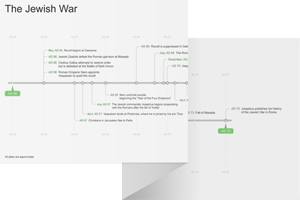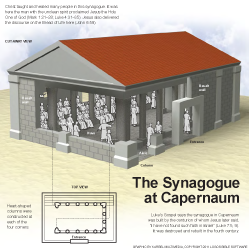3:1–6 Jesus demonstrates His lordship over the Sabbath |
3:2 they were watching him closely Probably refers to the Pharisees (v. 6).
(v. 6).
in order that they could accuse him Profaning the Sabbath was a capital offense (Exod 31:14–15; 35:2; Num 15:32–36).
Jesus Heals a Man’s Hand | ||
3:4 to save life or to kill Jesus’ question about the Sabbath is provocative and was intended to question common viewpoints (compare note on Mark 2:24). Elsewhere Jesus teaches that love of neighbor not only fulfills the law but is central to the kingdom of God (12:29–34). Here, Jesus tangibly demonstrates that human traditions and moral codes should not conflict with love of neighbor.
3:5 hardness of their hearts This biblical idiom, often rendered as “hardness of heart” (compare Exod 4:21 and note), indicates both stubbornness and opposition to God’s workings (Mark 2:6–8).
3:6 Pharisees See note on 2:16.
the Herodians A political party who generally supported Herod Antipas’ regime.
 Major Groups in Jesus’ Time Table
Major Groups in Jesus’ Time Table
3:7–12 Mark briefly summarizes the first phase of Jesus’ ministry by detailing the large region from which Jesus’ followers had come and the amazing actions that had drawn them. |
3:7 to the sea Jesus again follows a confrontation with the Pharisees by withdrawing to the sea, accompanied by crowds receptive to His ministry (compare 2:13).
Judea Roman province corresponding roughly to the ot kingdom of Judah, with Jerusalem as the capital. This list of places indicates that news of Jesus’ deeds has reached beyond Galilee (compare 1:39, 45).
3:8 Idumea A territory southeast of Judaea. The places mentioned here—Idumea, the region across the Jordan, Tyre, and Sidon—were inhabited predominantly by non-Jewish people, which suggests that Jesus was attracting non-Jews as well as Jews. Idumea is far south of Galilee, and Tyre is far north; this indicates the broad geographic spread of Jesus’ message. The reception of Jesus by Gentiles is a significant theme in Mark (5:1–20; 7:24–30, 31–37).
Idumea |
other side of the Jordan Also known as Perea.
Tyre and Sidon Two major Phoenician cities that dominated the Mediterranean coast to the north and west of Galilee.
that dominated the Mediterranean coast to the north and west of Galilee.
3:10 touch him The motif of Jesus healing by touch will become more prominent in the narratives that follow (5:25–34; 6:56; 7:32–37; 8:22–26; compare 1:40–45).
3:11 You are the Son of God Resembles the behavior of the first unclean spirit Jesus encountered in Mark’s Gospel—a cry, followed by recognition of Jesus’ identity (see 1:23–24; compare 15:39).
3:12 he warned them strictly Compare 1:25.
not make him known For first-century Jews, the Messiah was a political as well as a religious figure. Jesus’ desire to conceal His identity may have been motivated by a desire to avoid violent repercussions early in His ministry (compare note on 1:11).
3:13–19 Having proclaimed and enacted the arrival of God’s kingdom, Jesus now appoints others to multiply its effects. Echoing the twelve tribes of Israel, the twelve apostles likely serve as a symbolic reconstitution of the people of God around Jesus’ mission and teaching. |
3:13 went up Reflects Exod 24:1–11, where Moses summons Israel’s tribal leaders to join him on Mount Sinai.
3:15 authority to expel demons A key sign of the presence of God’s kingdom and Jesus’ deliverance of humanity (1:21–28).
3:16 Peter The Greek word for Peter, petros, means “rock.” Paul refers to Peter with the Aramaic form of this name, kephas (e.g., Gal 1:18), suggesting that Jesus originally gave him this name in Aramaic (the primary language of Jesus and His disciples).
3:17 Boanerges, that is, “Sons of Thunder” Mark includes what is presumably the original Semitic form of James and John’s new name. It is unclear why Jesus calls them this, but it may be because of their reputation as strong-willed people (compare Matt 20:20–28).
3:18 Matthew Since Levi the tax collector is not listed here, this seems to be a reference to him. Compare note on Mark 2:14.
James the son of Alphaeus Possibly the brother of Levi the tax collector (see 2:14).
collector (see 2:14).
the Zealot This title serves to distinguish Simon from Simon Peter. While most translations have “Zealot” here, some follow a manuscript that reads “Canaanite.” The two words are similar in Greek.
3:19 Iscariot The meaning of this epithet is uncertain. It could be a version of the Hebrew phrase ish qeriyyoth, meaning “the man from Kerioth,” referring to a town in Judaea. Alternatively, it could be an Aramaic slur, ishqarya', meaning “the false one.”
3:20–35 Despite Jesus’ growing fame, He receives a mixed reception from the religious leaders and even His own family. Jesus confronts the accusation that His ministry is fueled by demonic power. |
3:20 home See note on Mark 2:1.
3:21 his family The Greek idiom used here, meaning “the ones from his side,” can refer to anyone who is closely related to a person, whether by blood or voluntary association.
for they were saying Jesus’ family might have wanted to preserve their reputation. The political ramifications of Jesus’ actions and teaching also could have caused His family to attempt to restrain Him, for fear of reprisal from Roman authorities or local Jewish leaders. Alternatively, they might have not have believed that Jesus was the Messiah and so attempted to silence Him to avoid being ostracized from the religious system (believing that it, too, would reject Him). Since Jesus has been at the center of a crowd almost continuously since His first teaching in Capernaum, it is unclear why His family reacts now.
3:22 scribes See note on 1:22.
come down from Jerusalem This is the first time someone has come from beyond Galilee’s borders to challenge Jesus.
Beelzebul The context of this term suggests that these Jewish leaders understood this figure to be the ruler of the demons. See note on Matt 10:25.
3:23 in parables Jesus speaks in parables only three times in Mark’s Gospel (Mark 3:20–30; 4:1–34; 12:1–12). Jesus’ parables contained truths about the kingdom of God (4:10–12).
3:24 a kingdom is divided Jesus confronts the religious leaders with the possibility that, by opposing Him, they might be aligning themselves with evil powers. The defining mark of a disciple of God’s kingdom is allegiance to Jesus and His teaching (v. 35).
3:26 risen up against himself Likewise, Jesus cannot be possessed by Beelzebul, as that would mean that the ruler of demons has risen up against himself by vanquishing demons.
3:27 ties up the strong man Refers to Jesus triumphing over Satan during His temptation (1:12–13) and Jesus casting out demons. These exorcisms indicate that Beelzebul (the strong man in the parable) was defeated through Jesus’ resistance of temptation.
3:29 blasphemes against the Holy Spirit In this context, this refers to insistently and unapologetically misrepresenting the workings of the Holy Spirit as demonic.
3:31 his mother and his brothers arrived Possibly indicates that they were not among the family members who sought to restrain Jesus in v. 21. These brothers could be Mary’s sons or the sons of Joseph by a previous wife, if he was a widower prior to marrying Mary.
3:35 whoever does the will of God In first-century Graeco-Roman and Jewish society, it was a person’s family that primarily determined identity and social standing. Jesus’ teaching radically modifies this custom by prioritizing participation in the kingdom of God.

|
About Faithlife Study BibleFaithlife Study Bible (FSB) is your guide to the ancient world of the Old and New Testaments, with study notes and articles that draw from a wide range of academic research. FSB helps you learn how to think about interpretation methods and issues so that you can gain a deeper understanding of the text. |
| Copyright |
Copyright 2012 Logos Bible Software. |
| Support Info | fsb |
 Loading…
Loading…



 Idumea
Idumea 
